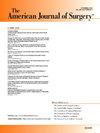Analysis of the incidence and outcomes of breast cancer in women with schizophrenia
IF 2.7
3区 医学
Q1 SURGERY
引用次数: 0
Abstract
Objective
Breast cancer (BC) is the leading cause of female cancer death in the world and the second leading cause of female cancer death in the U.S, Mortality from breast cancer is even higher in individuals with schizophrenia. The aim of our project was to evaluate the incidence of breast cancer in women with schizophrenia and to compare outcomes between breast cancer patients who were or were not on antipsychotics prior to diagnosis.
Methods
This retrospective study used data from the TriNetX database. Women ≥18 years old diagnosed with schizophrenia were identified. The incidence of primary BC diagnosis between January 2011 and December 2023 was evaluated and stratified by ethnicity.
We then conducted a retrospective cohort study to compare outcomes of women ≥18 years who did or did not use antipsychotics one year before BC diagnosis. Patients’ propensity score was matched based on age, obesity, tobacco use, socioeconomic status, cancer stage, chemoradiation, axillary lymph node dissection (ALND), sentinel lymph node biopsy (SLNB), and hormone therapy use. Outcomes of interest were 5-year overall survival, recurrence, chemotherapy need, and lymphedema.
Results
1,398,475 women ≥18 years old with schizophrenia were identified. Breast cancer incidence in these patients was 0.53 % in 2011 and 0.53 % in 2022, with a peak in 2017 (1.29 %). Non-Hispanic patients were diagnosed with BC approximately 1.3 times more than Hispanic patients.
The outcomes study included 183,062 matched patients, with 91,531 per cohort. 5-year survival with the Kaplan-Meier analysis was significantly greater in women not on antipsychotics (72 %) compared to those on antipsychotics (60 %), log-rank test p-value <0.0001. The risk of local recurrence (13.4 % versus 22.6 %, p-value <0.0001), chemotherapy need (41.2 % versus 48.4 %, p-value <0.0001), and lymphedema (7.7 % versus 11.5 %, p-value <0.0001) were also significantly lower in women who did not take antipsychotics.
Conclusion
Breast cancer incidence in patients with schizophrenia identified through TriNetX has not experienced a significant uptrend or downtrend over the past decade. Non-Hispanic patients with schizophrenia have a higher incidence of BC than Hispanic patients. Matched breast cancer patients on antipsychotics at least one year prior to diagnosis had higher mortality, recurrence, chemotherapy need, and risk of lymphedema.
精神分裂症女性乳腺癌发病率和预后分析。
目的:乳腺癌(BC)是全球女性癌症死亡的首要原因,也是美国女性癌症死亡的第二大原因。我们的项目旨在评估精神分裂症女性患者的乳腺癌发病率,并比较确诊前服用或未服用抗精神病药物的乳腺癌患者的治疗效果:这项回顾性研究使用了 TriNetX 数据库中的数据。方法:这项回顾性研究使用了 TriNetX 数据库中的数据。评估了 2011 年 1 月至 2023 年 12 月期间原发性 BC 诊断的发病率,并按种族进行了分层。然后,我们进行了一项回顾性队列研究,比较≥18 岁女性在 BC 诊断前一年使用或未使用抗精神病药物的结果。根据年龄、肥胖程度、吸烟情况、社会经济状况、癌症分期、化疗、腋窝淋巴结清扫(ALND)、前哨淋巴结活检(SLNB)和激素治疗的使用情况,对患者的倾向评分进行了匹配。研究结果包括 5 年总生存率、复发率、化疗需求和淋巴水肿:共发现 1,398,475 名年龄≥18 岁的精神分裂症女性患者。这些患者的乳腺癌发病率在 2011 年为 0.53%,2022 年为 0.53%,2017 年达到高峰(1.29%)。非西班牙裔患者被诊断为乳腺癌的比例约为西班牙裔患者的 1.3 倍。结果研究包括 183,062 名匹配患者,每个队列有 91,531 人。根据卡普兰-梅耶尔分析,未服用抗精神病药物的女性的5年生存率(72%)明显高于服用抗精神病药物的女性(60%),对数秩检验P值 结论:在过去十年中,通过 TriNetX 发现的精神分裂症患者的乳腺癌发病率并未出现明显的上升或下降趋势。非西班牙裔精神分裂症患者的乳腺癌发病率高于西班牙裔患者。至少在确诊前一年服用抗精神病药物的匹配乳腺癌患者的死亡率、复发率、化疗需求和淋巴水肿风险均较高。
本文章由计算机程序翻译,如有差异,请以英文原文为准。
求助全文
约1分钟内获得全文
求助全文
来源期刊
CiteScore
5.00
自引率
6.70%
发文量
570
审稿时长
56 days
期刊介绍:
The American Journal of Surgery® is a peer-reviewed journal designed for the general surgeon who performs abdominal, cancer, vascular, head and neck, breast, colorectal, and other forms of surgery. AJS is the official journal of 7 major surgical societies* and publishes their official papers as well as independently submitted clinical studies, editorials, reviews, brief reports, correspondence and book reviews.

 求助内容:
求助内容: 应助结果提醒方式:
应助结果提醒方式:


